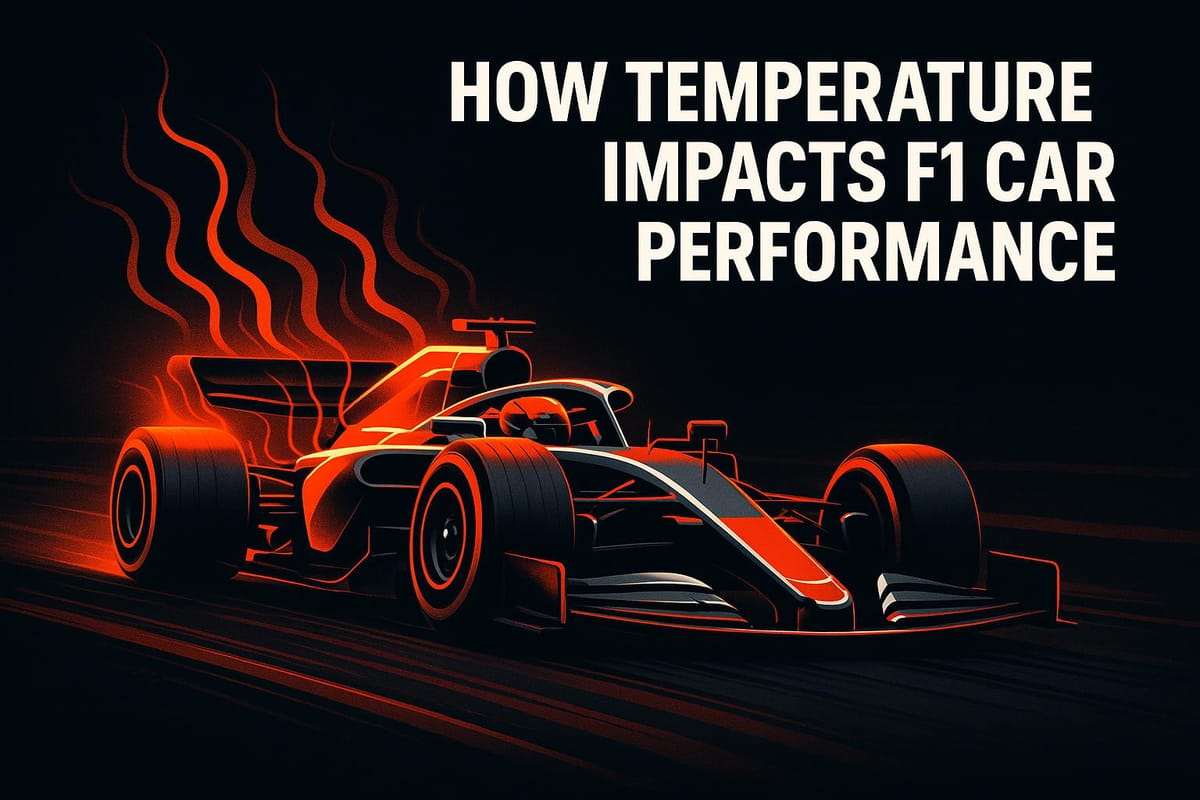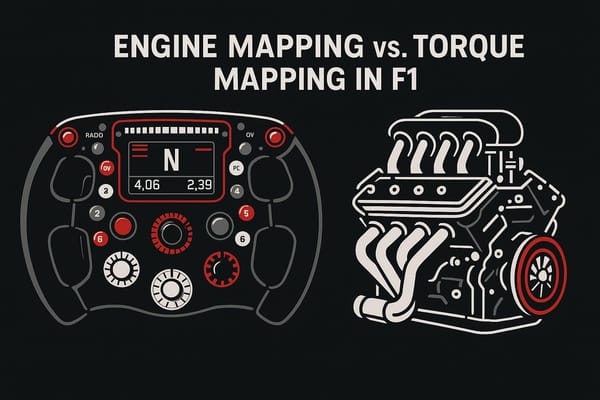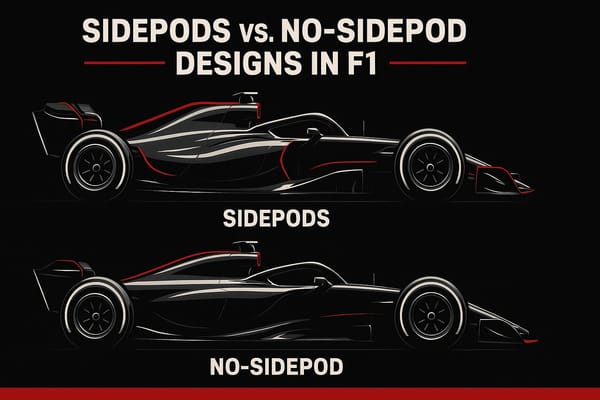How Temperature Impacts F1 Car Performance
Temperature significantly influences F1 car performance, affecting engines, tires, and aerodynamics, making thermal management essential for success.

Temperature directly affects F1 car performance by influencing engines, tires, and aerodynamics. Here's how it works:
- Engines: Cooler air improves engine power by increasing oxygen density, while high temperatures demand advanced cooling systems to avoid overheating.
- Tires: Each tire compound has an ideal temperature range. Overheating accelerates wear, while cold tires lack grip, affecting speed and handling.
- Aerodynamics: Warm air reduces density, decreasing downforce and increasing drag. Teams adjust setups to maintain balance.
Managing these factors during races, from engine cooling to tire strategies, is crucial for success. Teams constantly adapt to temperature changes to optimize performance.
What Impact Do Temperatures Have on an F1 Car?
Engine Temperature Effects
Modern F1 engines operate at combustion temperatures as extreme as 4,700°F (2,600°C), requiring precise thermal management to maintain performance and reliability.
Air Temperature and Engine Output
The surrounding air temperature directly impacts engine performance through air density. A drop of 18°F (10°C) boosts engine power by roughly 3% due to the increased oxygen available for combustion. This is why early morning qualifying sessions often yield faster lap times.
For example, during the 2024 Bahrain Grand Prix, Mercedes faced a 15°C (59°F) temperature increase in their W15 power units. This caused a 0.35-second per lap performance drop as the team had to reduce engine modes to protect key components.
Cooling System Adjustments
To counter the effects of ambient temperature on engine performance, teams continuously refine their cooling systems. These advanced systems are designed to keep engine temperatures within a range of 212–248°F (100–120°C).
| Cooling Component | Function | Performance Impact |
|---|---|---|
| Variable Louvers | Adjusts radiator airflow dynamically | 0.4s per lap variation |
| Dual Cockpit Intakes | Improves radiator efficiency | 12% better cooling |
| Active Clearance Control | Maintains turbo tolerances | ±0.03mm precision |
At the 2024 Japanese Grand Prix, Red Bull Racing introduced a forward cockpit cooling inlet. This design enhanced radiator efficiency by 12% without affecting aerodynamics.
Temperature-Related Engine Problems
Even with optimized cooling and performance, extreme temperatures can still lead to engine issues. During Ferrari's 2024 Bahrain test, a miscalibrated coolant pre-heating system caused 0.2mm block distortion. To address this, teams have adopted carbon-fiber reinforced bearings, which feature negative thermal expansion properties.
Statistics reveal that 38% of failures stem from cold-start camshaft damage, while 29% result from heat-induced exhaust valve warping when temperatures exceed 1,562°F (850°C). To combat these challenges, Mercedes uses single-crystal nickel alloys in their power units, which maintain structural integrity at temperatures up to 2,012°F (1,100°C).
Tire Temperature Management
In Formula 1, tire performance hinges heavily on maintaining the right operating temperature. Each tire compound is designed to perform best within a specific temperature range, which directly impacts grip, durability, and overall car performance. During a race, keeping tires in their ideal temperature window is critical for both speed and longevity.
Finding the Right Tire Temperature
Each compound - soft, medium, or hard - has its own sweet spot for temperature. Softer compounds typically need higher temperatures to reach peak grip, while harder compounds perform better at slightly cooler levels. Teams monitor tire temperatures closely throughout the race weekend, using this data to fine-tune strategies and ensure the tires perform as intended.
Heat Effects on Tire Wear
High track temperatures can cause tires to degrade faster, reducing their effectiveness over the course of a stint. Pushing tires beyond their optimal temperature range speeds up this wear. To counteract this, teams use methods like adjusting brake duct airflow and tweaking car setups to better regulate tire temperatures, especially in hot conditions.
Managing Cold Tires
In colder weather, warming up tires to their ideal range can be tricky. Tires that stay too cold lack the grip needed for optimal performance, particularly in the early laps. Teams tackle this issue with pre-race tools like tire blankets and by instructing drivers to use techniques that generate heat through mechanical friction. These steps help bring tires up to temperature quickly, ensuring they deliver consistent grip as the race unfolds. Proper tire management also lays the groundwork for making aerodynamic adjustments later on.
Temperature and Aerodynamics
Temperature changes don’t just impact engine and tire performance - they also affect how cars interact with the air around them. Variations in temperature alter air density, which in turn reduces downforce and increases drag. To stay competitive, teams must tweak their setups to keep aerodynamic performance in check.
Air Density Effects
Air density plays a key role in aerodynamics. Warmer air is less dense, meaning fewer air molecules are available to interact with the car’s wings and bodywork. This drop in density reduces the car’s ability to generate downforce and alters drag levels. To address this, teams make targeted adjustments to maintain optimal aerodynamic performance.
Aerodynamic Setup Changes
To handle the effects of temperature shifts, teams fine-tune various parts of the car. Adjusting wing angles and tweaking underbody elements are common strategies to balance downforce and drag. These changes are often made throughout the race weekend as conditions evolve, making flexible setups essential in modern F1 design.
With today’s F1 cars relying heavily on advanced ground effect designs and underbody aerodynamics, even small changes in air density can have a noticeable impact. Adapting to these shifts is critical for staying competitive on the track.
Race Planning and Driver Performance
Temperature plays a key role in shaping race strategies and influencing driver performance. From tire wear to cockpit conditions, temperature variations affect car setups, driver endurance, and on-track decisions. The same heat factors that impact engine performance and tire grip also guide critical strategic choices during a race.
Temperature-Based Race Tactics
Teams constantly tweak pit stop timing, tire selections, and car configurations based on ambient and track temperatures. Higher temperatures can speed up tire degradation, while cooler conditions may require longer warm-up times. To stay competitive, teams closely monitor weather forecasts and track conditions across the race weekend, making adjustments to get the most out of their cars and drivers.
Driver Response to Temperature
Racing in high heat takes a toll on drivers, leading to quicker fatigue and reduced focus. To combat this, teams work on improving cockpit ventilation, providing cooling gear, and fine-tuning hydration plans. These measures not only help drivers stay physically and mentally sharp but also have a ripple effect on race strategies.
Recent Temperature-Affected Races
Temperature management has proven to be a game-changer in many races. For instance, cooler qualifying sessions often result in longer tire warm-up periods, influencing both qualifying results and the strategies for race starts. These scenarios highlight how closely teams must balance technical adjustments with strategic planning to handle temperature challenges effectively.
Conclusion
Temperature management plays a crucial role in F1 racing, influencing everything from engine performance and tire durability to aerodynamic efficiency. The interaction between weather conditions and car dynamics requires precise coordination across various systems. On race day, a team's ability to manage these temperature-related factors often determines their success.
Teams make strategic investments in managing heat to gain both technical and tactical advantages. The effects of temperature on aerodynamics and driver performance push teams to prioritize thermal management as a way to secure an edge during races. Those who excel in this area often find themselves ahead, especially when conditions shift unexpectedly.
Modern thermal systems highlight how controlling heat can directly translate into competitive benefits. As weather and track conditions change throughout the season, teams continuously adjust and improve their strategies. This combination of technical expertise and strategic adaptability is what sets championship contenders apart.
Managing temperature isn’t just about keeping systems running smoothly - it’s about finding ways to outperform the competition in every scenario. Whether racing in Bahrain’s intense heat or on Europe’s cooler circuits, effective temperature control remains a cornerstone of F1 success, driving innovation and precision from both teams and drivers.
FAQs
How do F1 teams manage tire temperatures to optimize performance during a race?
F1 teams carefully manage tire temperatures throughout a race to ensure optimal performance and durability. Tires work best within a specific temperature range, and keeping them in this range is crucial for maintaining grip and avoiding excessive wear.
To achieve this, teams adjust strategies such as tire pressure, suspension settings, and aerodynamic balance to influence how heat is distributed. Drivers also play a key role by modifying their driving style - such as braking patterns and cornering speeds - to either heat up or cool down the tires as needed. Additionally, pit stop strategies are planned to align with the expected tire degradation and track conditions, ensuring the car remains competitive during changing temperatures.
How do F1 teams manage engine cooling in extreme heat during races?
F1 teams use a variety of advanced technologies to optimize engine cooling in high-temperature conditions. These include redesigned radiators and airflow systems that maximize heat dissipation without compromising aerodynamics. Teams also rely on heat-resistant materials and coatings to protect engine components from extreme temperatures.
Additionally, cooling strategies are adjusted in real-time during races. For example, teams may modify vent openings or adjust power unit settings to prevent overheating while maintaining performance. These innovations ensure cars can perform reliably, even in scorching conditions like those seen in races such as the Bahrain or Singapore Grand Prix.
How does air density influence the aerodynamics of F1 cars, and what adjustments do teams make to adapt?
Air density plays a crucial role in the aerodynamic performance of F1 cars. Higher air density, typically found in cooler temperatures or at sea level, increases downforce and drag, which can improve cornering grip but reduce straight-line speed. Conversely, lower air density, often experienced at higher altitudes or in warmer conditions, reduces both downforce and drag, impacting tire grip and overall stability.
To adapt, teams make adjustments to the car's aerodynamic setup. For example, they may modify the angle of the wings to balance the trade-off between downforce and drag. In higher-density conditions, teams might reduce wing angles to minimize drag, while in lower-density environments, they may increase wing angles to compensate for the reduced downforce. These fine-tuned changes are critical for optimizing performance based on track conditions and weather.




